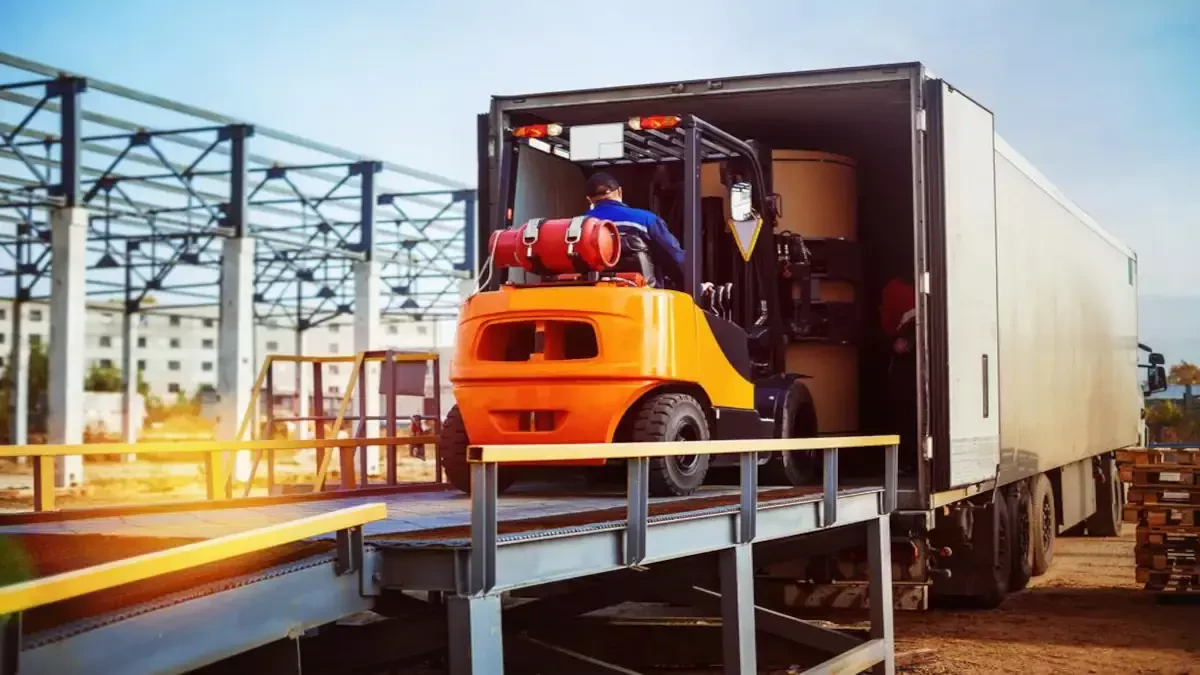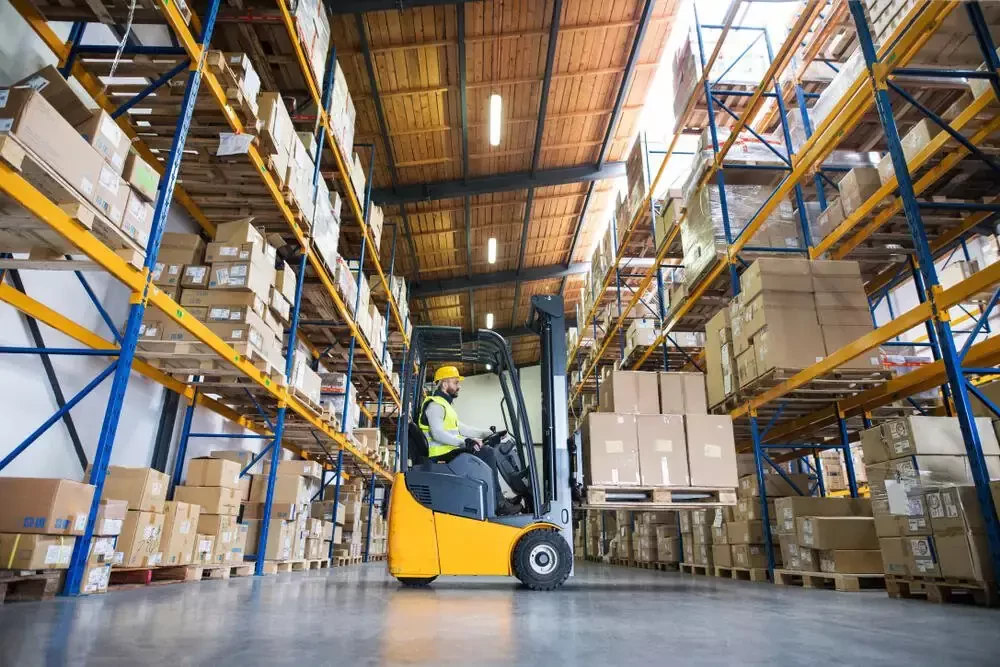How To Transport A Forklift: Resolved (2022 Updated)


A forklift may not be as heavy as a farm tractor or a bulldozer, but it’s still thrice as heavy as an average automobile.
Thus, transporting this machinery requires the proper skill, special consideration, and precision.
Considering its weight, size, and attachments, learn how to transport a forklift using these five effective ways without jeopardizing your forklift’s safety. Keep reading.
How Much Does It Cost To Transport A Forklift?
Generally, transporting a forklift may cost anywhere from $200 to $1,500, depending on various factors, whether you hire a hauling company or not.
If the forklift weighs heavier or its size is more significant than an average forklift, expect a more expensive forklift conveyance fee.
You’ll also pay more than usual if the delivery time is shorter. Rush delivery often costs more than regular delivery.
The forklift transport is also a deciding factor in whether you’ll pay additional or not. The open-air shipping method is cheaper than the enclosed trailer shipping method.
Do You Need Professional Help When Moving Forklifts?
Yes, you might need professional help because shipping forklifts isn’t easy. You might even pay more if you try to do everything from hiring trailers to logistics.
Doing the various processes alone is more costly than hiring hauling companies that provide an all-in-one package deal for the entire process.
Most companies provide skilled drivers, proper planning, safety/insurance coverage, forklift transport vehicles, and secure necessary permits.
Conclusion
To move a forklift, you must choose the best conveyance vehicle, secure the forklift, and observe safety protocols.
It’s also important to shut off the forklift’s power supply before the transport and check for vehicle clearance for safety purposes.
You can either opt to haul the forklift on your own by hiring a skilled driver, renting a conveyance vehicle, obtaining permits, or just hiring a shipping company.
Shipping a forklift? Contact A-1 Auto Transport for safe and secure forklift hauling nationwide.

References:
Frequently Asked Questions
How do you move a non-running forklift?
To move a non-running forklift, you can try to hook the dead forklift up to other car batteries.
You can also use a bigger forklift to move it or replace the non-running forklift’s battery with a charged one.
Can a forklift go into a box truck?
Yes, a forklift can go into a box truck only if it fits the box truck. However, you need to be extra careful, so ensure the welding spots underneath the cross members by chassis are still in good condition, or the forklift might slide to the side of the truck while traveling.
Can you push a forklift in neutral?
No, you cannot push a forklift in neutral. When a forklift is set into neutral, the machine is not in motion because the driver is either alighting the forklift or just parked it.
How much does a forklift weigh?
Most forklifts weigh between 3,000 and 20,000 pounds. The weight of a forklift depends on its size, make, and model.
1) Enclosed Trailer
An enclosed trailer is your best choice if you want to move a forklift at different construction sites with longer distances.
While flatbed trailers are best for small forklifts, an enclosed trailer can accommodate large equipment that is either too tall or too heavy for a flatbed truck.
Enclosed trailers will also ensure your forklift is covered and protected against a potentially hazardous situation. They can deliver the goods safely until they reach the final destination.
2) Flatbed Truck

A flatbed truck is your best choice if you want a fast and inexpensive forklift transport option from one job site to another.
A flatbed tow trailer offers enough space and substantial weight capacity to accommodate a forklift.
In addition, a flatbed trailer truck has a low deck, making it easier to safely load/lift your forklift while providing hassle-free clearance when traveling tunnels or bridges.
3) Tilt Tray Truck
If you wish to ship more than one forklift to any job/work site, we recommend using tilt tray trucks because they can accommodate up to almost four forklifts, depending on their sizes and weights.
Since a tilt tray truck can tilt, it’s easier to lift/load and unload the equipment even without a loading dock.
4) Shut Off The Fuel Supply
You must also shut off the fuel supply of your forklift by disconnecting its propane [2] tank from the forklift before towing.
Ensure no fuel will be spilled out of the tank, especially if the forklift is diesel-powered or gasoline-powered.
You must also disconnect the battery terminal, so no arcing will happen. And when you transport electric forklifts, recharging the battery before the forklift transport departs is advisable.
5) Check Vehicle Clearance
Checking the vehicle clearance is also an important matter to secure.
If the top of the forklift is taller than the transport vehicle, you must avoid driving through bridges and overpasses.
6) Observe Proper Transport
Knowing your forklift’s length, weight, and other dimensions is a must. Use a rated trailer to accommodate the forklift’s weight capacity. We recommend verifying the weight and length of your forklift using the machine’s manual.
Before the transportation, you must also ensure that your forklift is in excellent condition before loading it onto the trailer or truck. Check its forks and chains, and place blocks on its rear wheels.
Centering your forklift in a trailer is also important. You must lower its forks to the wooden floor when centering and tilt them forward slightly. You may use a loading dock to lift it easier. Always make the forks pointed toward the rear of the trailer.
Ensure the wheels are chocked (use wooden blocks) behind the wheels of the forklift to prevent unnecessary movement during transport. You can also use a nose jack under the trailer’s front to prevent it from tipping if it isn’t attached to a truck.
Secure the blocks by driving screws into each block and into the floor of the transport.
When loading your forklift on a trailer, ensure that you drive your heavy equipment onto the trailer in reverse and its forks point away from the forklift transportation vehicle.
7) Secure the Forklift
Securing your forklift [1] before and during transportation is also highly encouraged.
Place wood blocks behind the wheels of your forklift before the transport. Fasten the wood blocks into the wooden floor of the truck bed for better security.
We recommend using heavy-duty straps, chains, and come-alongs to secure your forklift. Securing every anchor point at each corner of your forklift will limit its movement during the travel, making it more securely placed/fastened on the floor trailer.
Use at least two come-alongs or chains to establish four anchor points in every corner of the forklift.
If you use flatbeds to transport forklifts, you must use nylon straps, heavy chains, and come-alongs to fasten your forklift onto the truck or trailer.


 Share on Facebook
Share on Facebook Share on LinkedIn
Share on LinkedIn Share on Twitter
Share on Twitter Google
Google  Instagram
Instagram 



